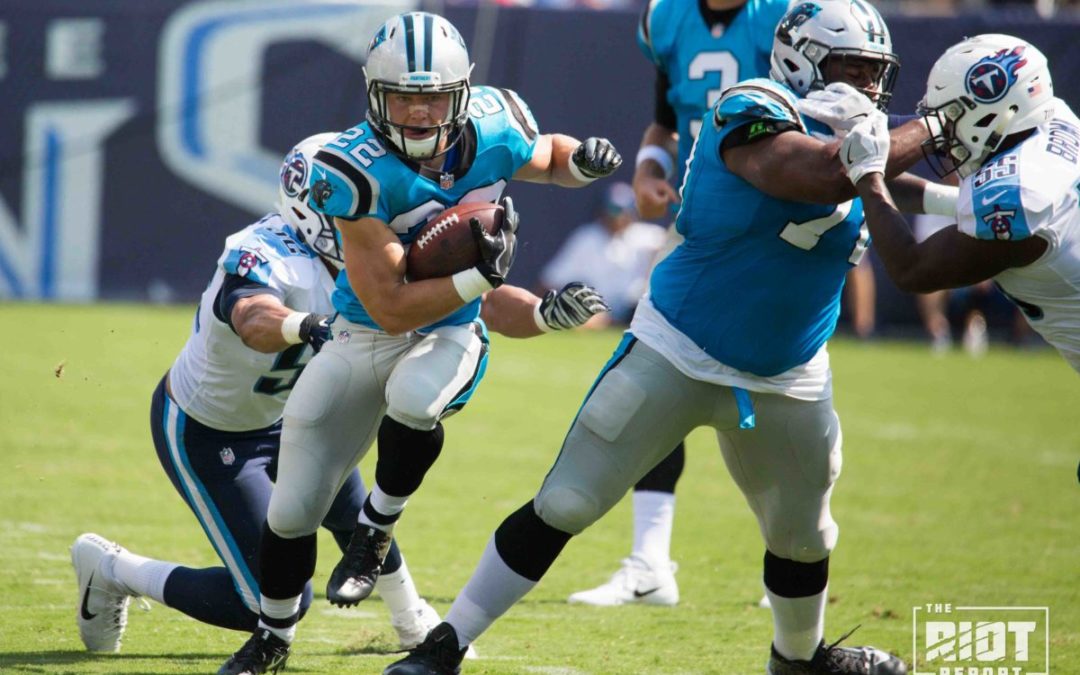The first post in this article explored how the Panthers have used running backs in the passing game over the past few seasons. By contrast, this second post will look to explore what it is that McCaffrey in particular brings to the passing game, and how other offenses could be a model for how to maximize his production in this area. Read the first post here to find the problem, and then we’ll find the solution.
The McCaffrey Factor
Before exploring how the Panthers could better use running backs in the passing game, it will be wise to examine what is so valuable about McCaffrey’s skill set. To begin with, let’s look at his route running and how he separates himself from other running backs in this area.
These three plays are all simple dagger or crossing routes. The running back releases out of the backfield and then runs across the face of the defender. Against zone coverage this is a simple timing route, with the ball being delivered between the two central defenders; against man it is designed to get the running back between the ball and the defender for an easy completion.
What McCaffrey does here that is so special is that he freezes at the break point of the route. This flat-foots the defender and allows McCaffrey to gain maximum separation which aids him after the catch. Nuances such as this are what separate elite route runners from the rest; to see them in a rookie, and a running back at that, is extremely rare.
It is clear that Stanford understood the talent they had in McCaffrey and used him extensively as a receiver out of empty sets. In the following play, McCaffrey shows the same ability to freeze the defender as he does coming out of the backfield.
Beyond simply being able to beat his defender, on the following two plays he shows an understanding of zone-beating routes. As expected, he initially sits down against the zone coverage but, when the ball doesn’t immediately come out, he shows awareness in moving to prevent the defender from closing on the route. In the first case, he motions across the field allowing the quarterback to hit him in stride for a run-after-catch first down.
On the second play, he rolls away from the zone defender to set up the easy completion. Such plays might not look hugely impressive but this understanding of schemes and feel for coverage is hugely important in limiting deflections and interceptions.
The other aspect of what McCaffrey was asked to do at Stanford, which could be incorporated into the Panthers’ passing game, is his ability to stretch the field vertically. There are limited examples of running backs being used in this way in the NFL, and this article will not explore this in much detail, but could well be a part of how the Panthers look to use McCaffrey.
With these skills in mind, we can now examine how other teams with similar running backs are able to use them for maximum effect.
The Solution
The appeal of using running backs as receivers should be fairly clear: they offer match-up potential due to their potential to be both ball carriers and pass catchers and their abilities offer the potential for added yards after the catch. They can turn a short pass into a big play or a check-down into a touchdown as below.
The Patriots are far from alone in emphasizing running backs in the passing game but they are the best at it. Even on simple short passes to running backs coming out of the backfield, a noticeable difference to the Panthers’ offense becomes clear. Before doing anything, it is important to set a standard for success: four yards. If an offense gains four yards every play then they will score. More than four yards is good, less than four yards is bad.
Now, let’s examine how the Panthers use Whittaker on a swing pass. Whittaker swings to the side with one receiver, and that receiver runs a short inside sit-down route. Newton hits Whittaker and he runs for four yards; an acceptable play.
Now examine these two plays from the Patriots. It should be noted that these are third down plays so the coverage is much tighter, as opposed to the off coverage the Panthers see in the above third down. If it helps, alternate the two plays with the one above and pay particular attention to the other receivers.
On the Patriots plays, they have the running back run to a spot that has been vacated by a receiver. Against man coverage, this presents a one-on-one opportunity with a linebacker and against zone; it forces the outside defender up and away from the line of scrimmage which gives the running back more room to make the catch and turn uphill. The following play is an example of how this can be effective on earlier downs.
The Patriots are very good at using these layers to force a defender to pick between the running back in the flat and the receiver behind them. Such plays turn two yard passes into four and five yard ones, a small but significant difference.
Lastly, from a scheme perspective, the Panthers could use McCaffrey’s receiving ability to open up space for other players. Short passes in general have the ability to both open up the deep pass by compacting coverages vertically and help in the running game by expanding coverages horizontally. However, where the Patriots and others are able to create significant additional value is in the use of layered pairings which create deeper open receivers.
For example, on the following play, the Chiefs’ running back runs a simple swing route into the flat which is vacated by the tight end. On the earlier plays, this forced the defender up the field in order to set up the running back reception. But, here, they run the tight end route back inside behind the flat defender. This creates a simple read play for the quarterback who merely reads the linebacker moving out to the flat and hits the tight end in the space the linebacker has just vacated.
Panthers fans should be optimistic about the potential incorporation of such a ‘twist’ route combination into the 2017 offense as Shula has used it in the past. Against New Orleans in 2015, the Panthers scored a pair of touchdowns using this pattern. In the first play, the Saints run a man blitz and Newton is able to simply dump the ball off to Tolbert for the score.
In the second play, the Saints drop back into zone coverage, Newton sees the linebacker sitting down in the flat, and hits Funchess on the slant for a score. Given how effective the Panthers show such a simple combination to be, it is surprising that it wasn’t used more.
Where the Patriots are especially ahead of the curve is in their use of running backs as receivers out of empty sets. By motioning running backs out of the backfield and splitting them out wide, they are able to force defenses into using safeties and even linebackers to cover running backs in man-to-man coverage.
As McCaffrey has already demonstrated throughout training camp and in the preseason, running backs such as himself have a significant advantage in such situations, often leading to easy completions. The only other option defenses have in such situations is to use zone coverages to take pressure of individual defenders. However, by splitting five men out wide, the Patriots are able to limit the number of potential blitzers and so simplify the potential reads for the quarterback.
Here, the Falcons attempt to bring pressure with five men, but this still allows the Patriots to pick up every rusher whilst also opening up plenty of space for Brady to pick apart the drop-back zone coverage. Adopting zone coverage in such situations is tantamount to allowing the offense to pick-up five yards, which would qualify as a good play.
Where the Panthers have let themselves down in this regard is in their use of those five receivers. On the following play the Panthers run an empty set and look to catch the defence in drop-back zone. However, the Broncos are in man coverage and, with all five Panthers’ receivers running zone-beaters, Newton has nobody to throw to. There is an argument that Newton should have read man coverage, but why design a play where all five receivers run what is effectively the same route.
And on this play, while the Panthers do run man-beating routes, three of them go to the same point on the field thereby making it easy to defend. Using McCaffrey out of empty sets has huge potential but the Panthers have to be smarter about how they do this.
Such route concepts could easily be the basis for several separate articles, but hopefully this gives just a flavor of the basic principles which underpin such concepts. For the Panthers to succeed, they will need to show a command of such principles as a basis for their offense. If they do, then McCaffrey could well justify such a high pick and become a nightmare for NFL defenses for the foreseeable future.



